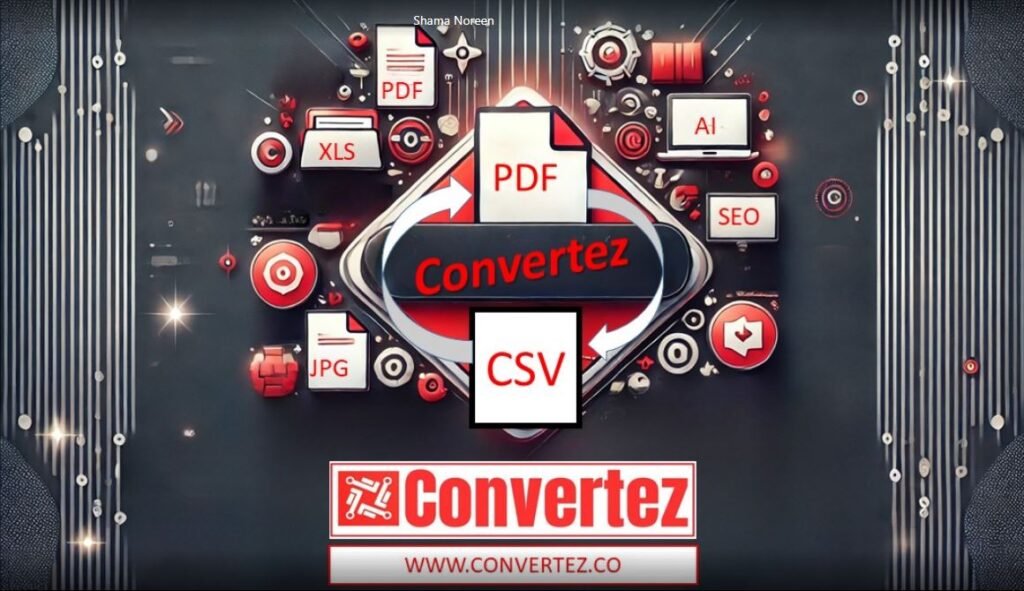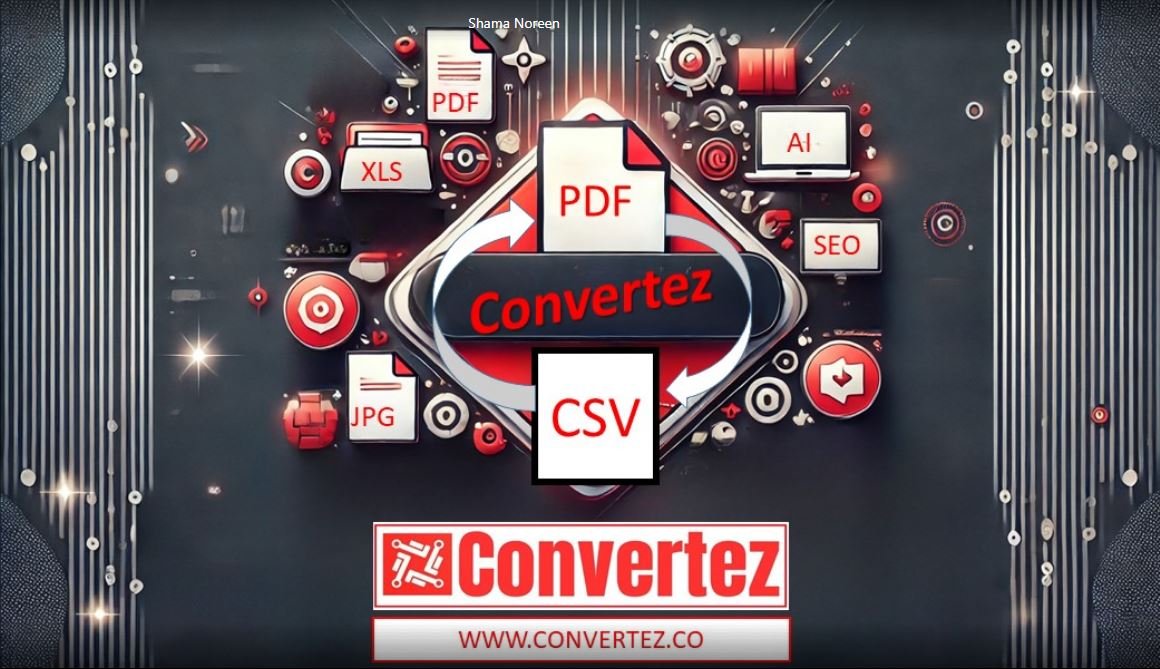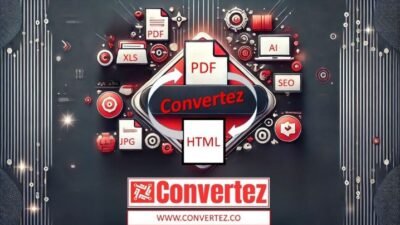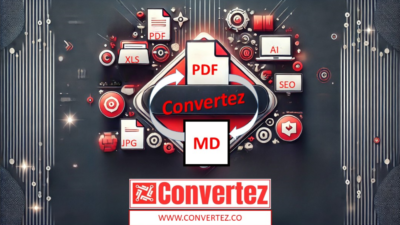In today’s digital era, data is everywhere—locked inside invoices, financial reports, inventory lists, survey forms, and countless other documents. More often than not, this valuable data is stored in PDF format, which is excellent for presentation and sharing but not ideal for editing or analysis. When it comes to organizing and analyzing structured data, CSV (Comma-Separated Values) is the preferred format. So, how do you bridge the gap between a non-editable PDF file and a dynamic, spreadsheet-friendly CSV file?
That’s where PDF to CSV conversion comes in.
In this comprehensive guide, we’ll explore everything you need to know about converting PDF files into CSV format—why it matters, how to do it, common challenges, and the best tools to simplify the process.
📌 What Is a PDF File?
PDF (Portable Document Format) is a file format developed by Adobe to present documents consistently across devices and platforms. It can contain text, images, tables, hyperlinks, and even interactive forms. But while PDFs are great for viewing and printing, they’re not designed for data manipulation or analysis.
📊 What Is a CSV File?
CSV (Comma-Separated Values) is a plain-text file format used to store tabular data. Each line represents a row, and each value is separated by a comma (or sometimes a semicolon). CSV files are widely supported by spreadsheet programs like Microsoft Excel, Google Sheets, and data analysis software.
Here’s an example of CSV data:
graphqlCopyEditName, Age, Email
John Doe, 29, john@example.com
Jane Smith, 35, jane@example.com
🔄 Why Convert PDF to CSV?
You might be wondering—why convert at all? Here are some key reasons:
1. Data Analysis
PDFs are not ideal for data analysis. Converting to CSV lets you use tools like Excel or Google Sheets to sort, filter, graph, and analyze the data.
2. Time-Saving
Manually copying data from PDFs into spreadsheets is time-consuming and prone to errors. Automated conversion saves hours of work.
3. Data Integration
CSV is a universal format used in many systems like CRMs, ERPs, and accounting tools. Once your data is in CSV format, it’s easier to import it into other applications.
4. Improved Accuracy
Tools that convert PDF to CSV reduce the risk of human error associated with manual data entry.

🚧 Common Challenges in PDF to CSV Conversion
Before diving into how to convert, let’s understand some of the hurdles that come with PDF to CSV conversion:
1. Complex Layouts
Not all PDFs are created equal. Some have complex tables, merged cells, or multi-column layouts that make extraction tricky.
2. Scanned PDFs (Image-Based)
Some PDFs are simply scanned images, not text-based documents. These require OCR (Optical Character Recognition) to extract the data.
3. Inconsistent Formatting
PDFs from different sources may not follow the same structure, which can confuse automated converters.
4. Data Cleanup
After conversion, some formatting issues (like misplaced commas or extra spaces) might still require cleanup in a spreadsheet editor.
🛠️ How to Convert PDF to CSV
There are multiple ways to convert PDF to CSV, depending on your preference and technical skill level.
1. Online PDF to CSV Converters (Recommended for Simplicity)
Platforms like Convertez.co offer free, fast, and reliable tools to convert your PDFs into CSV format without needing to install anything.
Steps:
- Go to Convertez.co
- Choose PDF to CSV from the tool list
- Upload your PDF file
- Click “Convert”
- Download your CSV file instantly
This is the easiest method for everyday users who need a quick solution.
2. Adobe Acrobat Pro
If you have Adobe Acrobat Pro, you can export a PDF as a spreadsheet and then save it as CSV.
Steps:
- Open your PDF in Acrobat Pro
- Click File > Export To > Spreadsheet > Microsoft Excel
- Save the Excel file and then open it
- Export or save it as a
.csvfile from Excel
This method is effective but requires a paid subscription.
3. OCR Software for Scanned PDFs
If your PDF is image-based (scanned), you’ll need an OCR tool like ABBYY FineReader, Tesseract, or Adobe Acrobat Pro with OCR to recognize text before conversion.
4. Python Scripts (For Developers)
For those who are tech-savvy, using Python libraries like pdfplumber, PyPDF2, or Tabula-py can automate the process for bulk conversions.
pythonCopyEditimport pdfplumber
import csv
with pdfplumber.open("data.pdf") as pdf:
with open("output.csv", "w", newline="") as csvfile:
writer = csv.writer(csvfile)
for page in pdf.pages:
table = page.extract_table()
for row in table:
writer.writerow(row)
This is ideal for developers handling large datasets or working on automated workflows.
🔍 Use Cases of PDF to CSV Conversion
Let’s look at some real-world examples of how this tool can help:
- Finance Teams extracting data from bank statements or invoices
- Researchers collecting survey data stored in PDFs
- HR Departments managing resume data or employment records
- Sales Teams analyzing purchase orders or customer data
- Data Analysts preparing reports based on PDF exports
🛡️ Is It Safe to Use Online PDF to CSV Converters?
Great question! Security is important.
Reputable tools like Convertez.co use secure encryption (HTTPS) and automatically delete uploaded files after conversion. However, for highly sensitive documents, it’s best to use desktop software or local scripts to keep everything offline.
✅ Tips for a Smooth Conversion
- Clean your PDF beforehand: If you can, simplify the layout before conversion.
- Check for OCR issues: If your PDF is scanned, verify the accuracy of the extracted data.
- Review the final CSV: Always open the resulting file and clean up any formatting issues.
- Batch process: Use tools that allow multiple file conversions if you’re working at scale.
🌐 Try It Now – Convert PDF to CSV Online
Want to experience how easy it is? Try our free online tool at Convertez.co/pdf-to-csv. No signup, no hassle—just fast and accurate conversion with one click.
📌 Final Thoughts
PDF to CSV conversion is a game-changer for anyone dealing with data. Whether you’re a professional analyst, a business owner, or a student, having the ability to extract clean data from PDFs can save you hours of work and open up new possibilities for analysis.
With the right tool—like the one offered at Convertez.co—you can convert files in seconds, streamline your workflow, and focus more on what matters: understanding and using your data.



